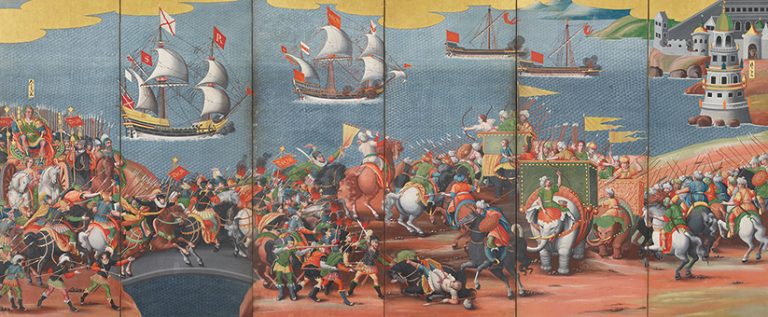The Kosetsu Museum of Art’s pair of folding screens, Battle of Lepanto and World Map (designated Important Cultural Property), represents an early Western_style masterpiece painted by Japanese artists who learned European painting techniques in the seventeenth century. This work perhaps symbolizes the encounter between Japan and the West that occurred due the Ages of Exploration by the Europeans.
Battle of Lepanto and World Maps is not only a unique work within the Kosetsu Museum collection, which primarily consists of Buddhist art and the utensils, but distinctive among early Western-style paintings for its composition, which is based on colorful European copperplate prints.
While introducing the Battle of Lepanto and World Map, this exhibition examines Western books and copperplate prints, which served as the source for these screens, as a point of comparison. In addition to early Western-style paintings, this exhibition traces works of art that exemplify the cultural exchange between Japan and Europe in the early modern period through the later Western-style paintings by artists such as Shiba Kōkan (1747-1818), Ishikawa Tairō (1762-1817), and Wakasugi Isohachi (1759-1805), who were influenced by Dutch illustrations and whose works showed new developments along with the rise of Dutch studies within the context of exchanges with The Netherlands in the mid-Edo period. Also presented is a variety of artworks including Japanese lacquerware made for European export, which were decorated with makie (sprinkled metal design) and mother-of-pearl inlay based on motifs from European copperplate engravings. We hope you enjoy these works that differ from traditional Japanese art.

Traces of Exchange:
From Early Western-style Paintings to Export Lacquerware
November 1, 2019 to December 8, 2019
Locations
Nakanoshima Kosetsu Museum of Art
4F Nakanoshima Festival Tower West,
3-2-4 Nakanoshima,
Kita-ku, Osaka, 530-0005
Japan
Phone: +81-(0)6-6210-3766